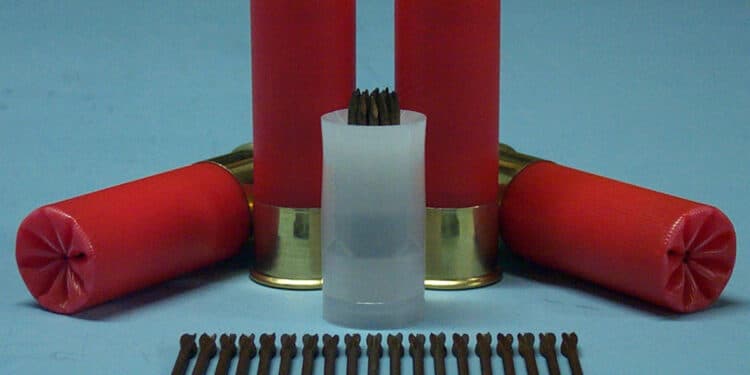The word “flechette” is French for “small arrow.” These little projectiles were first used in modern times in World War I when the ancestors of the WWII and Vietnam-era Lazy Dog bombs were dropped from the early airplanes. Later, they were used as projectiles in the first electromagnetic rail guns. There was little interest or work done on them between the wars, but in WWII they resurfaced as the Lazy Dog bomblets.
The U.S. Office of Strategic Services (OSS) used flechettes in mini crossbows and handgun spigot launchers. Spigot launchers were a device that went on the muzzle of the M1911A1 pistol, rather like a rifle grenade launcher. A rod acted as the firing pin extension to transfer the blow to the primer in the device. The cartridge was self-contained, as ignition drove a piston which did not leave the cartridge case, thereby containing the expanding powder gasses so that the cartridge produced little noise. The piston drove a big flechette ahead of it, which shot from the launcher as a projectile dragging the cartridge case with it.
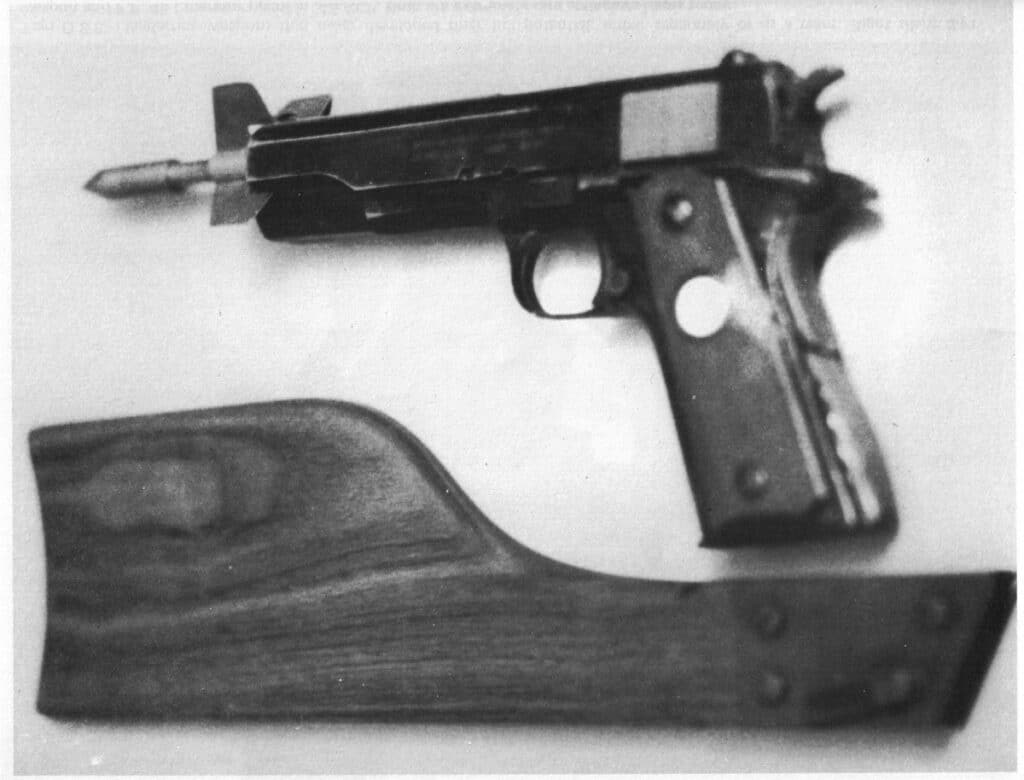
The big flechette had enormous killing power due to its size, which was important when only one shot can be made. The large flechette was more deadly than a small caliber handgun but produced similar or audible less report. This made the spigot launcher a single-shot weapon of great value for covert assassinations where the sound of a gun firing could alert the enemy forces and hinder escape.
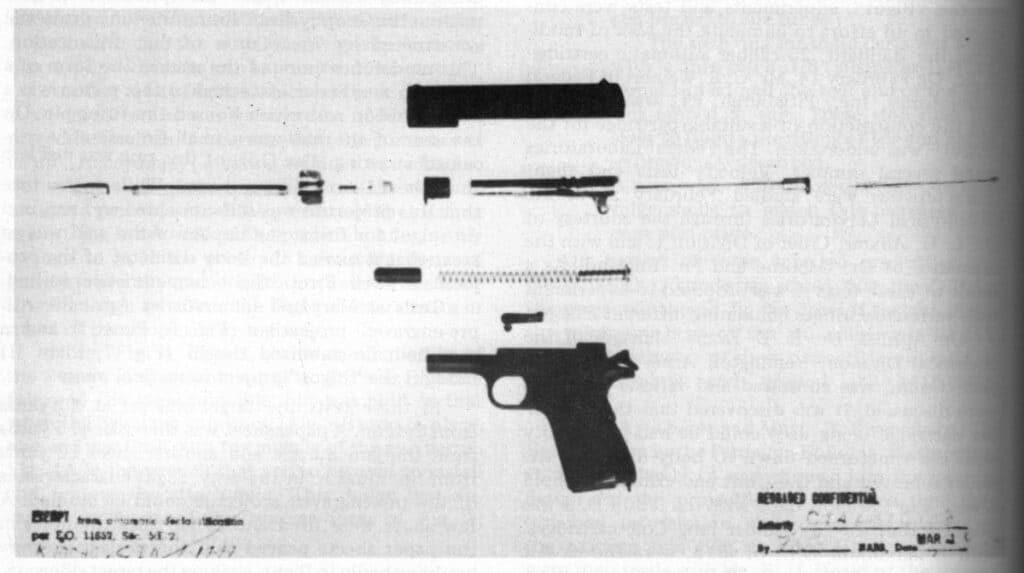
This system was used in Vietnam with Smith & Wesson .44 Magnum revolvers bored out to accept this sort of cartridge except that in these, the piston drove a conventional bullet out ahead of it. In these, the case stayed in the gun. These were well appreciated by the “tunnel rats” who had to fire in tightly confined spaces where the noise of a normal gun was greatly magnified to a permanently deafening level. A silent weapon was a necessity if you wanted to avoid deafness. The U.S. Navy also had a revolver firing one large flechette on this principle for underwater use. The Russians copied this design to work with smaller cartridges in a compact automatic pistol also adapted the design for use in an underwater gun.
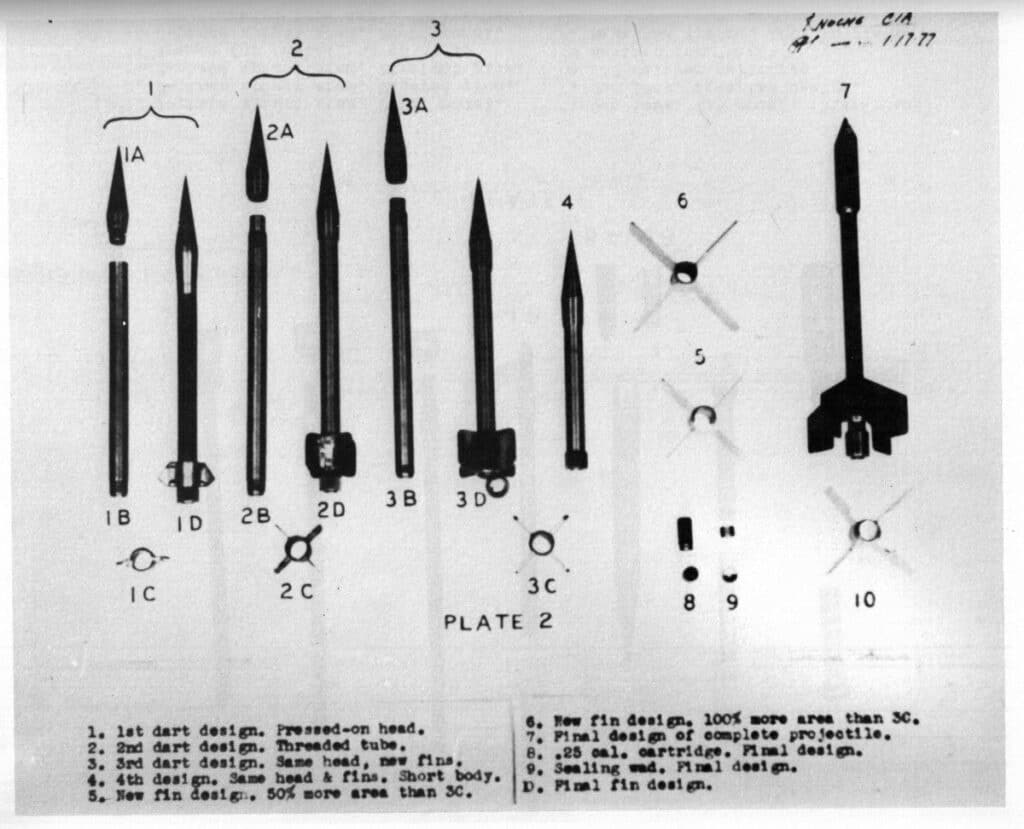
The need for an improved cannister round for tank guns led to research in flechettes loaded in artillery shells as an alternative. This research bore much fruit during the Vietnam War when flechettes were used in 12-gauge shotguns, 40 mm grenade launchers, 2.75-inch and 5-inch aircraft rockets, 81 mm riverine mortars, 90 mm and 106 mm recoilless rifles, 105 mm howitzers, 120 mm cannon, and in 90 mm, 105 mm, and 152 mm tank guns.
Anti-war protestors, championing the communist side in the Vietnam War, attacked the use of flechettes vehemently as these munitions were devastating to the communist forces attacking American soldiers. The political pressure they brought to bear resulted in a decline in the fielding of flechette systems, which left American forces more vulnerable to communist human wave assaults.
Today, Israel makes a copy of the U.S. 105 mm tank flechette round and both Russia and China reportedly maintaining large inventories of flechette ammunition for their major caliber artillery.
Current U.S. fielded flechette munitions include the 70 mm Hydra rocket (a modernized version of the 2.75-inch rocket), 84 mm Carl Gustov recoilless rifle munitions, and classified defense systems. Both the 70 mm Hydra rocket and the 84 mm Carl Gustov recoilless rifle flechette loads have been used in the Global War on Terror that began in 2001.
FLECHETTE SHOTGUN SHELLS
The use of flechettes in shotgun shells is the most common small arms employment of flechettes and the application of most interest to civilians. Credit for being the first to apply this concept to small arms goes to Irwin R. Barr of Aircraft Armament Co. in the early 1950’s. Originally, the idea was for one flechette per round and this led to the Army’s SPIW program. The first shotgun shells were loaded in 1953. These 32 flechettes-per-round loads were of a smaller size than those of today.
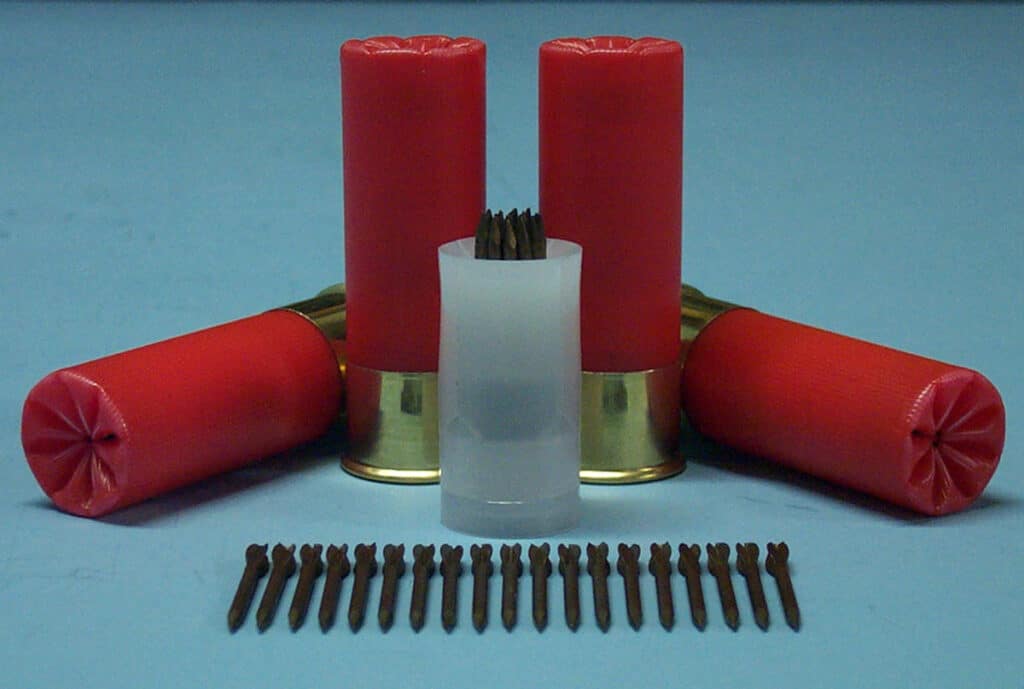
During the Vietnam War, flechette-loaded shotgun shells made kills out to 100 yards, proving their worth as a military weapon. Whirlpool Corporation had done development work on them, also loading many shells. Federal Ammunition made them, loading 25 flechettes per round while Western Cartridge Company’s load held 20 flechettes per round. Both of these rounds had their flechettes in a plastic cup buffered with granulated white polyurethane powder to maintain bore alignment. There was a metal disk at the rear of the cup the prevented the wad from being driven through the sharp tail fins of the flechettes. The tips of the flechettes were exposed and were visible at the mouth of the cartridge case These rounds would ruin a choke if fired through one, and they were only used in cylinder bore riot guns.
SPECIFICATIONS
| Manufacturer | Sabot Designs LLC |
| Make | 12-Gauge Flechette Load |
| Nomenclature | M1A8 |
| Projectiles | MIL-F-8167 Flechette (8-grain) |
| Packing | 19 Flechettes |
| Muzzle Velocity | 1925 FPS |
| Powder | Flake, 3-dram equivalent |
| Primer | Waterproof 209 equivalent |
| Chamber Length | 2.75 inches |
| Quality Standard | Mil-C-48656 Cartridges, Shotshells |
| URL | www.sabotdesigns.com |
Sometimes at gun shows, I have seen shotgun shells loaded with surplus artillery flechettes. Typically, some are loaded forwards and some backwards. Do not fire these in anything. They will tear up the inside of a shotgun barrel, as the hard steel of the flechettes will plow furrows in the bore and destroy any choke that gets in their way.
Properly loaded flechette shotgun shells are available from Sabot Designs LLC. The current loads are safe to use in any shotgun and will not hurt even a full choke, as the bore and choke are protected from the hard steel flechettes by a patented sabot that prevents any metal-on-metal contact. This was the invention of the firm’s oner, John Flannigan, and enables them to be used in any shotgun, not just cylinder bored riot guns.
Considered by many to be the greatest expert in flechette design and manufacture, much of Flannigan’s work remains classified, but what we can divulge is impressive. He made experimental tantalum flechettes for the Naval Surface Warfare Center’s Cargo Round. He designed and manufactured tungsten flechettes for the NSWC EMRG electro-magnetic rail gun sub-munition. His collaboration with General Dynamics Ordnance and Tactical Systems on the development and testing of the “High Density Packing” (HDP) cannister for the M1 Abrams tank resulted in his patent for the HDP Cannister round. Lockheed-Martin engaged him as a consultant for the fin design of the flechette projectiles for the Hydra-7 mine clearing system. The Marines Corps had him develop a flechette round for shooting down drones. That’s about all that we are free to talk about though.
FLECHETTES COMPARED TO BUCKSHOT
Comparing flechettes to the old standard, buckshot, reveals the strengths and weaknesses of both. Buckshot depends on its size, weight, and momentum to produce casualties. Of all projectiles, buckshot’s round ball deflects the least when hitting foliage and twigs. For this reason, it was often favored in jungle encounters.
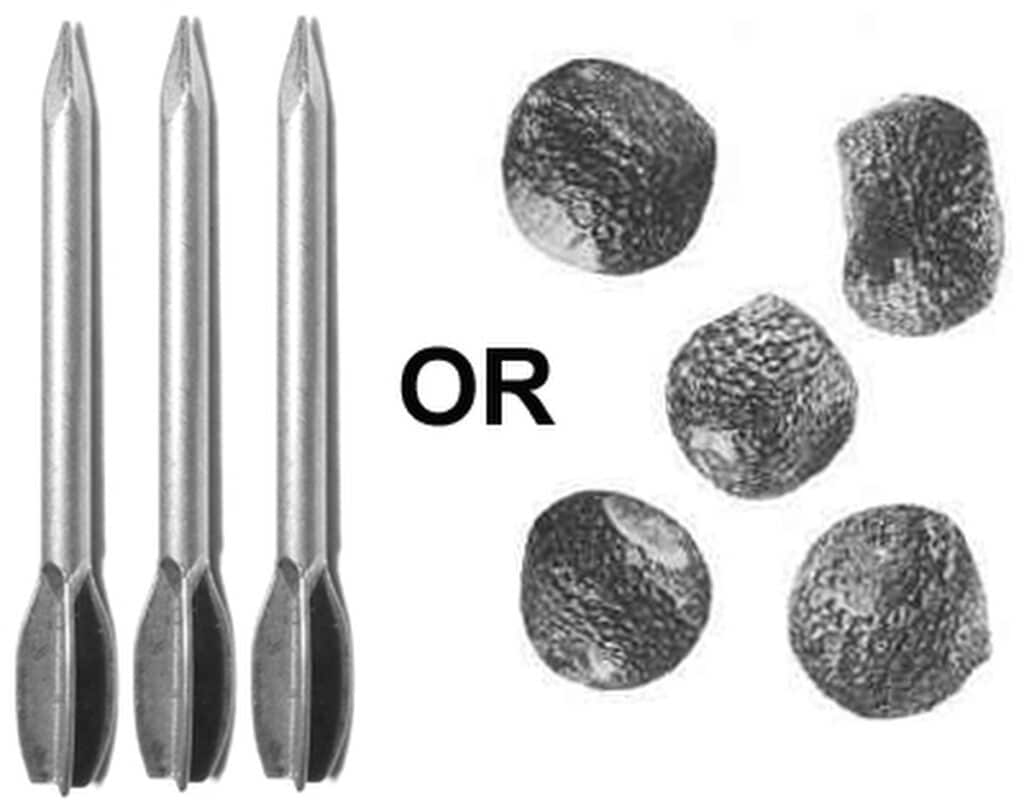
Flechettes have 211% more projectiles per shell than buckshot which greatly increases the chance of a hit at longer ranges. They have 19 projectiles compared to just nine in the military buckshot load. Flechettes are a near perfect aerodynamic shape, whereas the round ball is the least aerodynamic. Furthermore, lead balls tend to deform when fired so they are not even perfectly round anymore. At longer ranges this becomes more of a factor. Additionally, flechette loads weigh about half as much as an equivalent buckshot load, so combatants can carry more ammo into the fight.
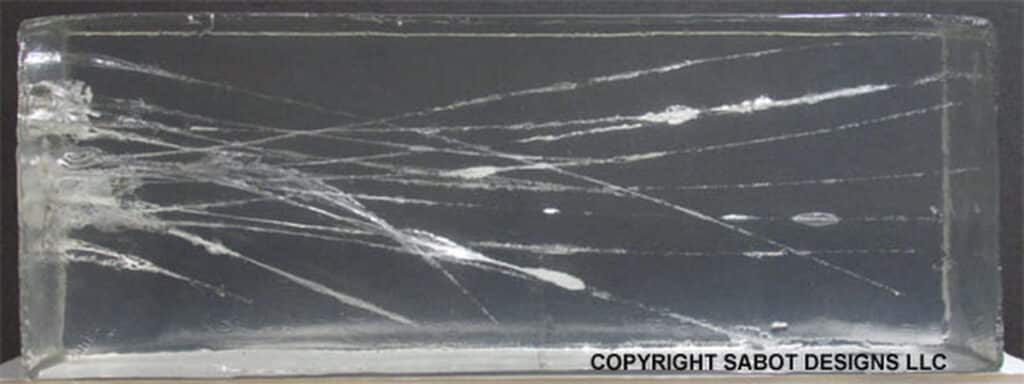
The stopping power of flechettes is a result of their velocity, penetration, and energy. Each flechette has the same energy signature as a 9 mm Parabellum round. It will shoot through a car door and produce a casualty on the other side, or it will go through over 20 inches of ballistic gelatin. Its energy is transmitted to a casualty by creating a supersonic cavitation wound channel. It will yaw off course as it penetrates, creating a wound channel approximately 800% larger than the flechette. This averages about .58 caliber for each flechette. Flechettes may also bend or break, creating secondary wound channels. They also typically shatter bones on contact.
ENGAGEMENT RANGES
| Average Point Target Range | 50 yd (45 m) |
| Maximum Point Target Range | 82 yd (75 m) |
| Maximum Area Target Range | 164 yd (158 m) |
| Maximum Effective Range* | 328 yd (300 m) |
* This being the longest range that a single flechette will produce a casualty.
CIVILIAN USE
12-gauge shotgun flechette loads are extremely useful to civilians. I’ve heard of a person taking out the heart and lungs of a wild hog at seven yards that was chasing and about to overtake his friend. Flechettes will penetrate the thick skull of an enraged bull or a 1000-pound hog when buckshot may fail. Flechettes have proven effective on deer, turkey, wild hog, and bear and are earning a devoted following among hunters. People depending on a shotgun for home defense are looking to flechette rounds for increased effectiveness.
Ever since the American Derringer Co. first invented the pistol chambering both the .45 Colt and the 2.5-inch .410 shotgun shell in 1980, there have been more companies making pistols that chamber these rounds interchangeably. Sabot designs makes a 2.5-inch .410 flechette load with seven flechettes for these.
Standard flechette rounds may not function reliably in automatic shotguns. Rounds that will reliably function a semi-auto are available under special order from Sabot Designs LLC.
Like birdshot, slugs, and buckshot, the flechette shotgun load has taken its place among the standard loads available for shotguns today.



